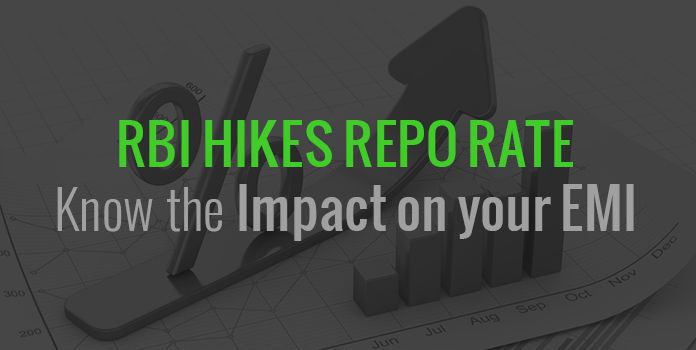What Does RBI’s 25 Basis Point Hike in Repo Rate Mean to Home Loan Borrowers?

Last Updated : Aug. 3, 2018, 12:22 p.m.
Much contrary to wide market expectations, the RBI sprung a surprise on its monetary policy meet on August 1, 2018, by raising the repo rate by 25 basis points to 6.50%, marking it as the second hike made by the central bank this year.
Banks are most likely to respond in the equal measure by raising the interest rates on lending products such as home loans, which is largely a floating based loan and get impacted by the fluctuations in the market rates.
Home loan interest rates, as of now, range from 8.45%-9.50% per annum. The per lakh EMI on a 20-year home loan remains ₹865-932 in the current context. If the banks hike rates by 25 basis points on an average, the per lakh EMI is set to grow to ₹881-949.
Now that the rate is on the rise, you must get ready to reduce the impending effect of home loan interest rates on your repayment life. There are some tips advised in this article which you can follow to reduce the impact.
Increase EMI Payout
The increase in rates may chuck out a lot of interest through the monthly installment. Banks generally increase the tenure in times of surging rates. However, you can just increase the EMI amount to tide over the situation. Let’s take an example to understand the situation better.
Example – On a 20-year home loan worth ₹50 lakhs at an interest rate of 8.60%,the EMI and interest payable amount to ₹43,708 and ₹54,89,953, respectively, over the course of 20 years.
If the bank hikes the tenure to 21 years keeping the rate rise in mind, the total interest payment is likely to be ₹60,22,781, assuming an increased rate of 8.85%.
However, by paying an extra EMI of ₹1,000 i.e. ₹44,708, the interest outgo can be reduced to ₹57,29,920.
The savings in interest by virtue of paying the extra EMI would amount to ₹2,92,861 (60,22,781-57,29,920).
Make an Apt Balance Transfer
The balance transfer becomes beneficial when you find a lender offering you the facility to shift your existing portfolio at a rate lower than your lender by about 25 basis points.
For example, your 20-year home loan of ₹50 lakhs is running for the last two years.
The interest rate on the same is assumed to be 8.95% per annum. The outstanding loan balance at the end of 2 years stands at ₹48,02,793. Seeing the trend of rate rise, you mull a balance transfer.
If you find a lender willing to take over the outstanding balance for the remaining 18 years at a rate of say 8.70% per annum, how much will it save for you? Let’s find out in the table below.
| S. No | Loan Details | Results |
|---|---|---|
| 1 | Original Loan | 50,00,000 |
| 2 | Current Rate of Interest | 8.95% |
| 3 | Original Tenure | 20 Years |
| 4 | Current EMI | 44826 |
| 5 | Interest Paid Over 2 Years | 8,78,609 |
| 6 | Interest Likely to Paid Over Entire 20 Years @ Current Rate | 57,58,153 |
| 7 | Outstanding Loan Balance | 48,02,793 |
| 8 | New Rate of Interest | 8.70% |
| 9 | New EMI | 44080 |
| 10 | Interest to be Paid on Balance Transfer | 47,18,433 |
| 11 | Interest Paid Over 2 Years + Interest to be Paid in the Next 18 Years | 55,97,042 |
| 12 | Savings in Interest Payment on Balance Transfer | 1,61,111 (57,58,153-55,97,042) |
Remember, the balance transfer has a cost associated with it. While some banks charge a flat amount, others keep a fee at a certain rate of the transferred amount. The balance transfer fee, if assumed to be ₹20,000, the savings would reduce to ₹1,41,111 but significant enough to go for the impending move.
Shall You Make a Part Payment?
Well, it’s a smart move to make a part payment and that too in the case of a floating rate home loan as there won’t be any penalty for the same, much unlike other loans where charges are applicable.
So if you have the savings, do use it to part pay the loan to cut down the outstanding balance and the interest outgo.
For example, your 20-year home loan of ₹50 lakhs is running for the last 2 years. The outstanding balance, as of now, must have been ₹47,94,577 at an assumed interest rate of 8.60%.
Now, if you part pay with a savings of say ₹2 lakhs, the outstanding balance would reduce to ₹45,94,577.
Let’s check out the table below to know the savings in prospect with such a move.
| Loan Amount (In ₹) | Interest Rate (In % p.a.) | Tenure (In Years) | EMI (In ₹) | Interest Outgo (In ₹) |
|---|---|---|---|---|
| 50,00,000 | 8.6 | 20 | 43708 | 54,89,953 |
| 45,94,577 | 8.6 | 18 | 41885 | 44,52,561 |
You can thus save an overall interest of ₹10,37,392 (54,89,953-44,52,561)